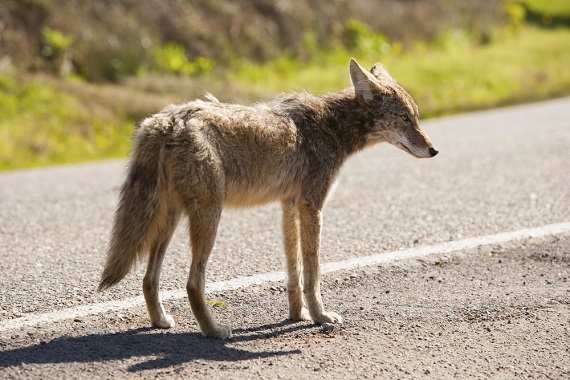Over the last day or two, headlines are filled with the story of a New Hampshire hero Dad who killed a coyote with his bare hands after it attacked his 2-year old son. There had been reports of coyote attacks in the area for a few days. Authorities caught and killed the animal and testing showed that it had rabies. This is a frightening story, but the Humane Society reports that thankfully, coyote attacks on humans are relatively rare.
Coyotes live in every US state except Hawaii. They are very adaptable to almost any environment – including cities and suburbs. They are scavengers that will eat just about anything. Right now, we are in peak breeding season, which generally runs from January to March.
One of the problems with living close to humans is that coyotes start to lose their fear of people. Instead of hiding, they can become bolder. Many pet owners have heartbreaking stories about having small pets grabbed from their yard by a coyote – or even snatched right off a leash in front of a horrified pet owner. While coyotes tend to be nocturnal, they can also roam around during the day. They are often spotted at daylight and dusk.
The Department of Agriculture’s Wildlife Services offer steps you can take to reduce the chance of human-coyote conflicts:
- Do not feed coyotes!
- Eliminate sources of water, particularly in dry climates.
- Bird feeders should be positioned so that coyotes cannot get feed.
- Do not discard edible garbage where coyotes can get to it.
- Secure garbage containers and eliminate garbage odors.
- Feed pets indoors whenever possible. Pick up any leftovers and store pet and livestock feed where it is inaccessible to wildlife.
- Trim and clean, near ground level, any shrubbery that provides hiding cover for coyotes or prey
- Fencing your yard could deter coyotes. The fence should be at least 6 feet high with the bottom extending at least 6 inches below ground level for best results.
- Don’t leave small children unattended outside if coyotes have been frequenting the area.
- Don’t allow pets to run free. Keep them safely confined and provide secure nighttime housing for them. Walk your dog on a leash and accompany your pet outside, especially at night.
- Discourage coyotes from frequenting your area. If you start seeing coyotes around your home or property, chase them away by shouting, making loud noises, or throwing rocks.
This last tip is commonly referred to as “coyote hazing”. The Humane Society has great resources on this topic – see Coyote hazing: Guidelines for discouraging neighborhood coyotes that focus on steps to change coyote behavior. Hazing is method that makes use of deterrents to move an animal out of an area or discourage an undesirable behavior or activity. Hazing can help maintain a coyote’s fear of humans and deter them from backyards and play spaces. The article suggests dog-walking tools and ways to keep them out of your yard.
Prior wildlife posts:
- When wild animals decide to take a swim in your pool
- Unusual perils in your morning commute: will your insurance cover this?
- Watch the roads: Autumn is peak deer-vehicle collision season
- Bees, spiders and other creepy crawlies can be dangerous driving distractions
Reprinted from Renaissance Alliance – no usage without permission.






